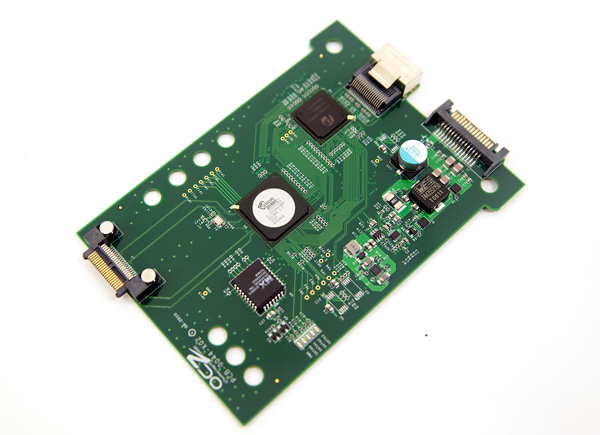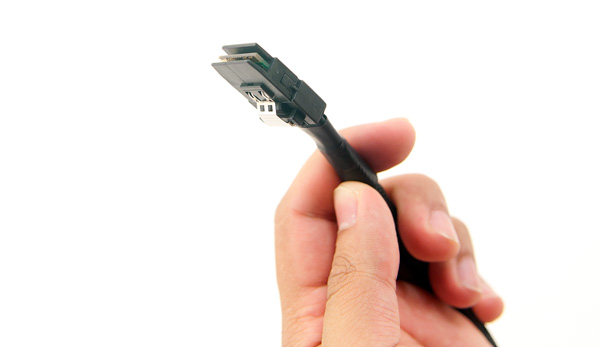OCZ's Fastest SSD, The IBIS and HSDL Interface Reviewed
by Anand Lal Shimpi on September 29, 2010 12:01 AM ESTFinal Words
The OCZ IBIS is very fast as you’d expect. Technically it’s the fastest SSD we’ve ever tested, but that’s because it’s actually four SF-1200 SSDs in a single 3.5” chassis. From a cost standpoint you’re better off grabbing four SandForce drives and rolling your own RAID, but if for whatever reason you don’t want to do that then a single IBIS will get the job done. It's faster than a Colossus by a huge margin and even faster than OCZ's recently introduced RevoDrive, you just need the workload to stress it.
I’m very comfortable with SandForce as a controller when it comes to not having TRIM. The IBIS’ garbage collection is aggressive enough to fix any significant fragmentation with a bit of idle time.
As I mentioned earlier however, the real goal here is to RAID multiple IBIS drives together with the 4-port card. We measured maximum sequential throughput of 675MB/s for a single IBIS drive, assuming somewhat linear scaling you can expect over 2.5GB/s out of a 4-drive IBIS array. This would be all off of a single PCIe x16 card. At this point the 4-port cards aren’t bootable, OCZ believes it is still several weeks away from having that support enabled.
Introducing a new interface is a very bold move for a company whose start was as just another memory vendor. I asked Ryan if motherboard manufacturers were signed up to deliver boards with HSDL connectors, he said they were. Although motherboard manufacturers often agree to do a lot that doesn’t end up being a launched, retail product. Motherboard makers aren’t the only ones who have taken notice as apparently RAID card manufacturers also want a piece of the HSDL pie. All of this is completely up in the air at this point. It’s one thing to mention you have lots of interest, it’s another to point at a mature market with products actually launching. Getting any company, much less a motherboard or RAID card manufacturer to commit resources to delivering features that support a market of zero is a tall order. I’m not saying it can’t be done, I’m saying that if Ryan Petersen can achieve it, he will have been the first to do it among a long list of memory companies who tried to be something more.
Ryan and OCZ are doing what they’re good at: finding a niche and trying their best to get there quicker than the big guys. There’s simply no PCIe SSD standard for the high end. For a single PCIe SSD there’s not much need, but if you want to RAID together multiple PCIe SSDs you’ll either run out of PCIe slots or have a very fast, very unbootable RAID.
The HSDL standard is completely open. OCZ tells me that there’s no licensing fees and all companies are completely free to implement it. In fact, that’s what OCZ would like to see happen. Currently the only way to get the HSDL spec is to contact OCZ and request it but the company is apparently working on setting something up a little more open. At the end of the day OCZ still wants to make money selling SSDs. HSDL’s success would simply let the company sell more expensive SSDs.
Drives will be available in two weeks but let's hope some of these integrated motherboard designs pan out.
HSDL sounds like a simple solution to the problem of delivering more interface bandwidth to SSDs. The interface should scale well since it’s built on PCIe, it’s just a matter of whether or not companies will support it. I believe it’s at least worth a try.












74 Comments
View All Comments
clovis501 - Wednesday, September 29, 2010 - link
If this innovation will eventually make it's way down to personal computer, it could simplify board design by allowing us to do away with the ever-changing SATA standard. A PCI Bus for all drives, and so much bandwidth than any bus-level bottleneck would be a thing of the past. One Bus to rule them all!LancerVI - Wednesday, September 29, 2010 - link
One bus to rule them all! That's a great point. One can hope. That would be great!AstroGuardian - Wednesday, September 29, 2010 - link
I want AT to how me how long will it take to install Windows 7 from a fast USB stick, install all the biggest and IO hungry apps. Then i want to see how long will it take to start them all @ the same time having been put in the Start-up folder. Then i want to see how well would work 5 virtual machines doing some synthetic benchmarks (each one @ the same time) under windows 7.Than i will have a clear view of how fast these SSD monsters are.
Minion4Hire - Wednesday, September 29, 2010 - link
Well aren't you demanding... =pPerisphetic - Thursday, September 30, 2010 - link
...or the past.Well it's probably deja vu, sounds like it.
This is exactly what the MCA (Micro Channel architecture) bus did.back in the day. My IBM PS/2 35 SX's hard drive connected directly to this bus which was also the way the plug in cards connected...
jonup - Wednesday, September 29, 2010 - link
"Even our upcoming server upgrade uses no less than fifty two SSDs across our entire network, and we’re small beans in the grand scheme of things."That's why the prices of SSD stay so high. The demand on the server market is way to high. Manufacturers do not need to fight for the mainstream consumer.
mckirkus - Wednesday, September 29, 2010 - link
I hate to feed trolls but this one is so easy to refute...The uptake of SSDs in the enterprise ultimately makes them cheaper/faster for consumers. If demand increases so does production. Also enterprise users buy different drives, the tech from those fancy beasts typically ends up in consumer products.
The analogy is that big car manufacturers have race teams for bleeding edge tech. If Anand bought a bunch of track ready Ferraris it wouldn't make your Toyota Yaris more expensive.
Flash production will ramp up to meet demand. Econ 101.
jonup - Wednesday, September 29, 2010 - link
Except that there is a limited supply of NAND Flash supply is limited while the demand for Ferraris does affect the demand for Yarises. Further, advances in technologies does not have anything to do with the shortage for Flash. Still further, supply for flash is very inelastic due to the high cost of entry and possibly limited supply of raw materials (read silicon).p.s. Do yourself a favor, do not teach me economics.
jonup - Wednesday, September 29, 2010 - link
Sorry for the bump, but in my original massage I simply expressed my supprise. I was not aware of the fact that SSD are so widely available/used in the commercial side.Ushio01 - Wednesday, September 29, 2010 - link
I believe the random write and read graphs have been mixed up.